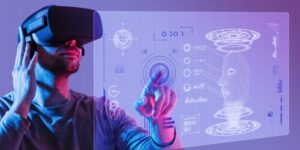The introduction of 5G technology will be a watershed moment in the telecommunications industry. It is expected to revolutionize the way we communicate, work, and access information. 5G technology will be available in 2023, and its impact on our lives and the world will be far-reaching.
5G technology will make our lives more connected, efficient, and secure. This new technology will have significant benefits for businesses of all sizes. It will allow for faster streaming speeds, improved latency, and more reliable connections. Additionally, 5G will enable the Internet of Things (IoT), allowing for the full realization of the potential of connected devices. It will also open up possibilities for new applications and services that have not been possible before.
The impact of 5G technology on businesses in 2023 will be profound. We will experience improved performance in all aspects of our operations, from customer service and collaboration to supply chain management and manufacturing. It will also create new opportunities for businesses to innovate and capitalize on the new technology.
The introduction of 5G technology in 2023 will transform the way we live our lives. Here are some specific ways 5G technology will benefit our lives in the coming years:
1. Speed and Performance
One of the biggest benefits of 5G technology is the increased speed and performance it will offer. With 5G, users will be able to download and upload data faster than ever before. This means streaming services like Netflix, YouTube, and Hulu will become even more efficient. 5G will also reduce latency, meaning users will be able to send and receive data faster than ever before. Additionally, 5G networks will be more reliable than their predecessors, meaning users will be able to access data and services without interruption.
Here are some specific examples of how the increased speed and performance of 5G will benefit users
- Streaming: With 5G, users will be able to stream high-definition (HD) or even 4K video without any buffering or lag. This will make it possible to watch movies and TV shows on the go without having to worry about the quality of the stream.
- Gaming: 5G will also make online gaming more enjoyable. With lower latency, gamers will be able to react to events in real time and enjoy a more immersive experience.
- Virtual reality (VR) and augmented reality (AR): 5G will be essential for the development of VR and AR applications. These technologies require high bandwidth and low latency in order to provide a seamless experience.
- Remote working and learning: 5G will make it possible for people to work and learn remotely without any disruptions. With high-speed and reliable connectivity, employees and students will be able to access all the resources they need, even when they are not in the office or classroom.
- Industrial automation: 5G will be used to connect and control devices in industrial settings. This will enable the development of smart factories and other automated systems that can operate more efficiently and safely.
These are just a few of the many benefits that 5G speed and performance will offer. As 5G networks continue to roll out, we can expect to see even more innovative and exciting applications for this technology.
2. Connectivity
The advent of 5G technology has drastically improved the connectivity capabilities of users. Enhanced data speeds allow for high-definition video and audio transmission, while increased reliability makes it possible to stay connected even in areas with weaker reception. Furthermore, 5G networks can accommodate an unprecedented number of devices, allowing simultaneous connection to multiple gadgets. A smartphone user is able to use common apps such as Uber and Fitbit while watching live TV on a tablet and eating dinner made by a robot.
Here are some specific examples of how the improved connectivity of 5G will be used:
- Smart cities: 5G will be used to connect and control devices in smart cities. This will enable the development of applications such as traffic management, energy management, and environmental monitoring.
- Industrial automation: 5G will be used to connect and control devices in industrial settings. This will enable the development of smart factories and other automated systems that can operate more efficiently and safely.
- Healthcare: 5G will be used to connect medical devices and provide remote patient care. This will improve the quality of care and make it possible for people to receive care in remote areas.
- Education: 5G will be used to deliver educational content and provide remote learning opportunities. This will make it possible for people to learn from anywhere in the world.
- Entertainment: 5G will be used to stream high-quality video and audio content. This will make it possible to enjoy entertainment on demand, regardless of location.
3. Internet of Things (IoT)
A connected network of devices that can be controlled from a remote location is called the Internet of Things (IoT). The IoT allows companies to connect with customers in ways they could not before. Sensors can be placed on machines and directly connected to the cloud, instead of sending data to a central computer for analysis.
One major benefit is that this will allow companies to cut costs associated with equipment and personnel. Think about how much cheaper it is to build cars with sensors that tell you when components need replacing before they break down, as opposed to hiring mechanics to replace those parts on an as-needed basis.
When 5G networks go online in 2018, the IoT will expand beyond its current size. 5G will increase data transfer rates over the 4G technology that’s most widely used today, so more information will be sent between devices. This means more efficient data processing and storage, which will open up possibilities for new applications and services, like super-precise EKGs or real-time language translation.
4. Education
5G technology will have a profound impact on education. In the same way that 4G made it easy to watch streaming movies and videos from anywhere in the world, 5G’s ultra-fast speeds can stream lectures and classes remotely. Students will be able to access materials from anywhere in the world, without having to be physically present in a classroom. The network can connect multiple devices at once, allowing for more interactive and engaging classes. 5G technology will also create new types of occupational training for young people and people with disabilities.
5G technology has the potential to revolutionize the education sector in a number of ways. Here are some of the ways that 5G can be used in education:
- Remote learning: 5G’s ultra-fast speeds and low latency make it possible to deliver high-quality remote learning experiences. Students can attend classes from anywhere in the world, and they can interact with their teachers and classmates in real time.
- Virtual reality and augmented reality: 5G can be used to deliver virtual reality (VR) and augmented reality (AR) experiences in the classroom. This can make learning more immersive and engaging, and it can help students to learn in new and innovative ways.
- Smart classrooms: 5G-enabled smart classrooms can be equipped with sensors, cameras, and other devices that can collect data on student learning. This data can then be used to personalize learning experiences and to identify students who need additional help.
- Collaborative learning: 5G can be used to facilitate collaborative learning. Students can work together on projects, even if they are not in the same physical location. This can help students to develop their teamwork and communication skills.
- Industry training: 5G can be used to deliver industry training. This can help students to learn the skills they need to get a job in a particular field. For example, 5G could be used to train auto mechanics remotely, without the need for them to visit a physical auto shop.
Accessibility: 5G can make education more accessible to people with disabilities. For example, students with hearing impairments can use 5G to access real-time captioning of lectures.
5. Entertainment
The latest generation of mobile network technology, 5G is so fast that an hour-long TV show will download in less than eight seconds. 1 Images and video are indistinguishable from the real thing. Users can stream shows anywhere, with no buffering or delays. There’s no time to lose; once you start watching something, you don’t want to wait for it to load or buffer. Movies or shows will be ready for people as soon as they click on them. Bandwidth won’t be an issue, since 5G supports a whopping 100 gigabits per second. All this means there is no need to wait or even press “play,” because the content is already there.
6. Work
5G networks will also make it easier for people to work from anywhere. With faster speeds and more reliable connections, users will be able to access their work files, applications, and services more quickly and efficiently than ever before. Businesses will be attracted to the speed of 5G and will benefit from this high-speed connectivity, which makes it more convenient for them to collaborate with remote workers no matter where they are located. The speed of 5G also means that data can be transferred almost instantly, enabling a collaboration in real time and allowing freelancers to access their work files whenever they want to.
7. Transportation
Autonomous vehicles are at the vanguard of a new revolution in transportation. In just a few decades, our streets will be filled with self-driving cars. Our roads won’t hold out for them, though: 5G technology will let vehicles communicate with each other without human interference to avoid accidents and create safer travel conditions.
The continued development of autonomous cars will transform our roads from hotbeds of rage into digital highways that facilitate easier traffic flow and lead to greater safety on all fronts. Since these cars can access real-time data such as road conditions, weather reports, and alternate routes, they’ll make it much simpler to find smoother paths and quicker commutes. As 5G technology becomes more readily available, vehicular communications will become faster and smarter.
8. Healthcare
5G technology will also have a major impact on healthcare. Doctors can access patient records more quickly and transmit the data across town or around the world via secure channels. This will enable telecom companies to develop new telemedicine services that can diagnose patients remotely. Additionally, 5G networks allow doctors to monitor multiple devices at once and use them for diagnoses or treatment.
9. Agriculture
5G technology will transform agriculture. The faster speeds and more reliable connections can be leveraged to connect everything from sensors on plants and tractors to databases of soil conditions and weather patterns. This data can then be used to optimize farming techniques for improved yields and reduced costs.
Additionally, the capacity of 5G networks can connect multiple devices at once in a way that allows for more efficient monitoring of farm operations. The network is therefore able to monitor temperature, humidity and other environmental conditions on a large scale to determine if any changes should be made to these parameters
5G technology has the potential to transform the agriculture industry in a number of ways. Here are some of the ways that 5G can be used in agriculture:
- Precision agriculture: 5G can be used to collect and analyze data from sensors on plants, soil, and weather stations. This data can then be used to optimize farming practices, such as fertilizer use, irrigation, and crop rotation.
- Remote monitoring: 5G can be used to remotely monitor farm equipment and livestock. This can help farmers to detect problems early on and take corrective action.
- Drones: 5G can be used to control drones that are used for tasks such as crop spraying, field mapping, and livestock monitoring.
- Self-driving tractors: 5G can be used to connect self-driving tractors and other agricultural machinery. This can help to improve efficiency and reduce labor costs.
- Virtual fencing: 5G can be used to create virtual fences that can help to keep livestock in a designated area. This can help to prevent animals from straying and getting lost.
- Smart irrigation: 5G can be used to control irrigation systems based on real-time data on soil moisture and weather conditions. This can help to improve water efficiency and reduce costs.
10. Retail
5G technology will also have a major impact on retail businesses. With faster speeds and more reliable connections, customers will be able to shop online with ease and convenience. This will increase the efficiency of the shopping experience by reducing wait times and enabling customers to make quicker decisions. Additionally, 5G networks can connect multiple devices at once, allowing retailers to provide personalized offers based on customers’ interests or past purchases in real-time.
5G technology is expected to have a major impact on the retail industry. Here are some of the ways that 5G can be used in retail:
- Improved online shopping experience: 5G’s faster speeds and lower latency will make it possible for customers to shop online with ease and convenience. They will be able to browse websites and load pages much faster, and they will be able to watch videos and stream music without any buffering. This will make online shopping a more enjoyable experience for customers.
- Real-time personalization: 5G’s ability to connect multiple devices at once will allow retailers to provide personalized offers to customers in real time. For example, a retailer could send a notification to a customer’s phone when they are near a store with a sale on their favorite product. This type of personalized marketing can be very effective at driving sales.
- Virtual reality and augmented reality: 5G’s high bandwidth and low latency will make it possible for retailers to use virtual reality (VR) and augmented reality (AR) to enhance the shopping experience. For example, a retailer could create a VR experience that allows customers to try on clothes or furniture before they buy them. AR could be used to provide information about products or to help customers find their way around a store.
- Self-service checkout: 5G’s high speeds and reliability will make it possible for retailers to implement self-service checkout systems. This can free up employees to focus on other tasks, such as customer service.
- Smart shelves: 5G-enabled smart shelves can track inventory levels and automatically reorder products when needed. This can help retailers to reduce out-of-stock situations and improve customer satisfaction.
In-store navigation: 5G can be used to provide in-store navigation for customers. This can help customers to find the products they are looking for quickly and easily.










